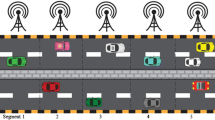Abstract
Vehicular ad hoc network (VANET) is an emerging trend where vehicles communicate with each other and possibly with a roadside unit to assist various applications like monitoring, managing and optimizing the transportation system. Collaboration among vehicles is significant in VANET. Resource constraint is one of the great challenges of VANETs. Because of the absence of centralized management, there is pitfall in optimal resource allocation, which leads to ineffective routing. Effective reliable routing is quite essential to achieve intelligent transportation. Stochastic dynamic programming is currently employed as a tool to analyse, develop and solve network resource constraint and allocation issues of resources in VANET. We have considered this work as a geographical-angular-zone-based two-phase dynamic resource allocation problem with a homogeneous resource class. This work uses a stochastic dynamic programming algorithm based on relaxed approximation to generate optimal resource allocation strategies over time in response to past task completion status history. The second phase resource allocation uses the observed outcome of the first phase task completion to provide optimal viability in resulting decisions. The proposed work will be further extended for the scenario that deals with heterogeneous resource class. Simulation results show that the proposed scheme works significantly well for the problems with identical resources.







Similar content being viewed by others

References
Castanon D A and Wohletz J M 2009 Model predictive control for stochastic resource allocation. IEEE Trans. Autom. Control 54(8): 1739–1750
Puterman M L 2005 Markov decision processes: discrete stochastic dynamic programming. New York: John Wiley and Sons
Fricker J D and Whitford R K 2004 Fundamentals of transportation engineering: a multimodal systems approach. Englewood Cliffs: Prentice Hall
Rawat D B, Song M and Shetty S 2015 Resource allocation for cognitive radio enabled vehicular network users. In: Dynamic Spectrum Access for Wireless Networks. New York: Springer, pp. 57–65. ISBN: 978-3-319-15299-8
Bejaoui T 2014 QoS-oriented high dynamic resource allocation in vehicular communication networks. Sci. World J. 2014: 718698
Xing W, Wang N, Wang C, Liu F and Ji Y 2014 Resource allocation schemes for D2D communication used in VANETs. In: Proceedings of the 80th IEEE Vehicular Technology Conference, Vancouver, pp. 1–6. https://doi.org/10.1109/VTCFall.2014.6966159
Araniti G, Campolo C, Condoluci M, Iera A and Molinaro A 2013 LTE for vehicular networking: a survey. Commun. Mag. 51(5): 148–157
Krishnamurthy V 2002 Algorithms for optimal scheduling of hidden Markov model sensors. IEEE Trans. Signal Process. 50(6): 1382–1397
Chhetri A S, Morrell D and Papandreou-Suppappola A 2006 On the use of binary programming for sensor scheduling. IEEE Trans. Signal Process. 55(6): 2826–2839
Miller M and Vaidya N 2005 A MAC protocol to reduce a sensor network energy consumption using a wakeup radio. IEEE Trans. Mob. Comput. 4(3): 228–242
Chhetri A S, Morrell D and Papandreou-Suppappola A 2006 Sensor resource allocation for tracking using outer approximation. IEEE Trans. Signal Process. Lett. 14(3): 213–216
Kaufman B, Lilleberg J and Aazhang B 2013 Spectrum sharing scheme between cellular users and ad-hoc device-to-device users. IEEE Trans. Wirel. Commun. 12(3): 1038–1049
Jarupan B and Ekici E 2009 Location and delay aware cross layer communication in V2I multi-hop vehicular networks. IEEE Commun. Mag. 47(11): 112–118
Williams J L, Fisher III J W and Willsky A S 2005 An approximate dynamic programming approach to a communication constrained sensor management problem. In: Proceedings of the International Conference of Information Fusion, July
Lim J M Y, Chang Y C, Alias M Y and Loo J 2014 Joint optimization and threshold structure dynamic programming with enhanced priority scheme for adaptive VANET MAC. Wireless Netw. 22(3): 897–913, https://doi.org/10.1007/s11276-015-1009-x
Cheung M H, Hou F, Wong V W and Huang J 2012 DORA: dynamic optimal random access for vehicle-to-roadside communications. IEEE J. Commun. 30(4): 792–803
Dhurandher S K, Misra S, Obaidat M S, Gupta M, Diwakar K and Gupta P 2010 An efficient angular routing protocol for inter-vehicular communication in vehicular ad hoc networks. IET Commun. 4(7): 826–836
Paramasivan B, Bhuvaneswari M and Pitchai K M 2015 Augmented DTN based energy efficient routing protocol for vehicular ad hoc networks. In: Proceedings of the 2015 IEEE SENSORS Conference, Busan, pp. 1–4. https://doi.org/10.1109/ICSENS.2015.7370257
Vakilinia S, Qiu D and Ali M M 2014 Optimal multi-dimensional dynamic resource allocation in mobile cloud computing. EURASIP J. Wirel. Commun. Netw. https://doi.org/10.1186/1687-1499-2014-201
Author information
Authors and Affiliations
Corresponding author
Rights and permissions
About this article
Cite this article
Bhuvaneswari, M., Paramasivan, B. & Kandasamy, A. Stochastic dynamic programming model for optimal resource allocation in vehicular ad hoc networks. Sādhanā 43, 52 (2018). https://doi.org/10.1007/s12046-018-0853-7
Received:
Revised:
Accepted:
Published:
DOI: https://doi.org/10.1007/s12046-018-0853-7



